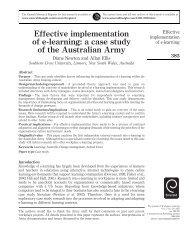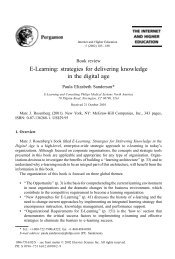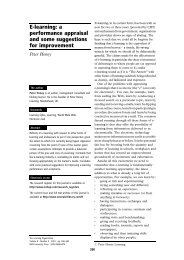Designing E-learning Interactions in the 21st Century: revisiting and ...
Designing E-learning Interactions in the 21st Century: revisiting and ...
Designing E-learning Interactions in the 21st Century: revisiting and ...
You also want an ePaper? Increase the reach of your titles
YUMPU automatically turns print PDFs into web optimized ePapers that Google loves.
Andrew Ravenscroft 155<br />
PILKINGTON, R. & GRIERSON, A. (1996) Generat<strong>in</strong>g explanations <strong>in</strong> a simulationbased<br />
<strong>learn<strong>in</strong>g</strong> environment, International Journal of Human-Computer<br />
Studies, 45, pp. 527±551.<br />
PILKINGTON, R. M. & MALLEN, C. L. (1996) Dialogue games to support reason<strong>in</strong>g<br />
<strong>and</strong> reflection <strong>in</strong> diagnostic tasks. Proceed<strong>in</strong>gs of European Conference on<br />
Artificial Intelligence <strong>and</strong> Education, Lisbon, Portugal, September 30±<br />
October 2, pp. 220±225<br />
PILKINGTON, R. M. & PARKER-JONES, C. (1996) Interact<strong>in</strong>g with computer-based<br />
simulation, Computers <strong>and</strong> Education, 27, pp. 1±14.<br />
PILKINGTON, R. M., TREASURE-JONES, T. & KNESER, C. (1999) Educational CHAT:<br />
us<strong>in</strong>g Exchange Structure Analysis to <strong>in</strong>vestigate communicative roles <strong>in</strong><br />
CMC sem<strong>in</strong>ars, <strong>in</strong>: P. BRNA, M. BAKER & K. STENNING (Eds) Roles of<br />
Communicative Interaction <strong>in</strong> Learn<strong>in</strong>g to Model <strong>in</strong> Ma<strong>the</strong>matics <strong>and</strong> Science:<br />
Proceed<strong>in</strong>gs of C-LEMMAS TMR Conference. 15th±19th April, Ajaccio,<br />
Corsica (Computer Based Learn<strong>in</strong>g Unit, University of Leeds).<br />
RAVENSCROFT, A. (1997) Learn<strong>in</strong>g as Knowledge Ref<strong>in</strong>ement: A Computer Based<br />
Approach. Unpublished Ph.D. Thesis (University of Leeds, Computer Based<br />
Learn<strong>in</strong>g Unit).<br />
RAVENSCROFT, A. (2000) <strong>Design<strong>in</strong>g</strong> argumentation for conceptual development,<br />
Computers & Education, 34, pp. 241±255.<br />
RAVENSCROFT, A. & HARTLEY, J. R. (1999) Learn<strong>in</strong>g as knowledge ref<strong>in</strong>ement:<br />
design<strong>in</strong>g a dialectical pedagogy for conceptual change, <strong>in</strong>: LAJOIE, S. &<br />
VIVET, M. (Eds) Frontiers <strong>in</strong> Artificial Intelligence <strong>and</strong> Applications Volume 50,<br />
Artificial Intelligence <strong>in</strong> Education. Open Learn<strong>in</strong>g Environments: New<br />
Computational Technologies to Support Learn<strong>in</strong>g, Exploration <strong>and</strong><br />
Collaboration (Amsterdam, IOS Press, pp. 155±162).<br />
RAVENSCROFT, A. & PILKINGTON, R.M. (2000) Investigation by design: develop<strong>in</strong>g<br />
dialogue models to support reason<strong>in</strong>g <strong>and</strong> conceptual change, International<br />
Journal of Artificial Intelligence <strong>in</strong> Education, 11, pp. 273±298<br />
RAVENSCROFT A., TAIT K. & HUGHES, I. E. (1998) Beyond <strong>the</strong> media: knowledge<br />
level <strong>in</strong>teraction <strong>and</strong> guided <strong>in</strong>tegration for CBL systems, Computers &<br />
Education, 30, pp. 49±56.<br />
RETALIS, S., PAIN, H. & HAGGITH, M. (1996) Argu<strong>in</strong>g with <strong>the</strong> Devil: Teach<strong>in</strong>g <strong>in</strong><br />
Controversial Doma<strong>in</strong>s. Proceed<strong>in</strong>gs of Third International Conference on<br />
Intelligent Tutor<strong>in</strong>g Systems 1996, Montreal, Canada, pp. 659±677.<br />
SKINNER, B. F. (1954) The science of <strong>learn<strong>in</strong>g</strong> <strong>and</strong> <strong>the</strong> art of teach<strong>in</strong>g. Harvard<br />
Educational Review, pp. 88±97.<br />
STELLA. (1992) STELLA II: an <strong>in</strong>troduction to systems th<strong>in</strong>k<strong>in</strong>g (Hanover, NH,<br />
High Performance Systems Inc).<br />
SUTHERLAND, R. (1983) Connect<strong>in</strong>g <strong>the</strong>ory <strong>and</strong> practice: results from <strong>the</strong> teach<strong>in</strong>g<br />
of LOGO, Educational Studies <strong>in</strong> Ma<strong>the</strong>matics, 24, pp. 95±113.<br />
TAIT, K. (1994) DISCOURSE: <strong>the</strong> design <strong>and</strong> production of simulation-based<br />
<strong>learn<strong>in</strong>g</strong> environments, <strong>in</strong>: DE JONG, T. & SARTI, L. (Eds) Design <strong>and</strong><br />
Production of Multimedia <strong>and</strong> Simulation-based Learn<strong>in</strong>g Material<br />
(Dordrecht, Kluwer Academic Publishers).<br />
TOLMIE, A. & BOYLE, J. (2000) Factors <strong>in</strong>fluenc<strong>in</strong>g <strong>the</strong> success of computer<br />
mediated communication (CMC) environments <strong>in</strong> university teach<strong>in</strong>g: a<br />
review <strong>and</strong> case study, Computers & Education, 34, pp. 119±140.<br />
TUDGE, J. (1990) Vygotsky, <strong>the</strong> Zone of Proximal Development <strong>and</strong> Peer<br />
ß Blackwell Publishers Ltd 2001
















